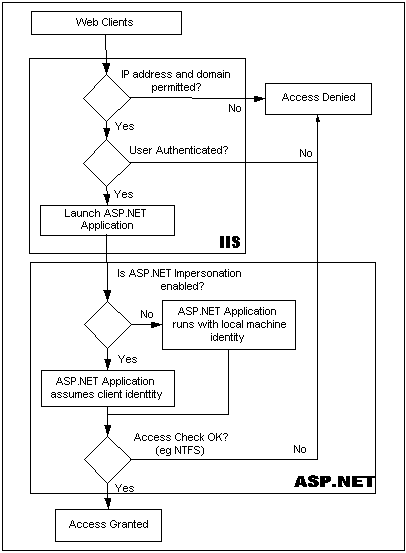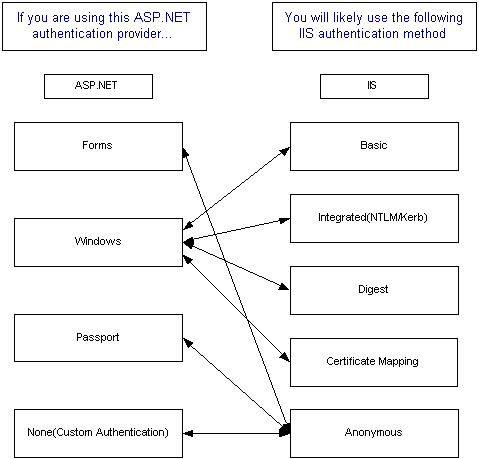Security is a major concern for both application architects and developers. Applications that store sensitive information need to be protected from malicious attacks and from competitors attempting to steal information or intellectual property. When designing a security model for your application, you need to be aware of security requirements from a business perspective and the implications that a chosen security model can have on performance, scalability, and deployment.
Relationship Between IIS and ASP.NET
You should understand the relationship between Internet Information Services (IIS) authentication and the Microsoft® ASP.NET security architecture when designing your application. This will allow you to authenticate your users appropriately and obtain the correct security context within your application. You should note that ASP.NET application security configuration and IIS security configuration are completely independent and can be used independently or in conjunction with each other.
IIS maintains security related configuration settings in the IIS metabase. However, ASP.NET maintains security (and other) configuration settings in XML configuration files. While this generally simplifies the deployment of your application from a security standpoint, the security model adopted by your application will necessitate the correct configuration of both the IIS metabase and your ASP.NET application via its configuration file (Web.config).

The security relationship between IIS and ASP.NET
ASP.NET Authentication Providers and IIS Security
ASP.NET implements authentication using authentication providers, which are code modules that verify credentials and implement other security functionality such as cookie generation. ASP.NET supports the following three authentication providers:
- Forms Authentication. Using this provider causes unauthenticated requests to be redirected to a specified HTML form using client side redirection. The user can then supply logon credentials, and post the form back to the server. If the application authenticates the request (using application-specific logic), ASP.NET issues a cookie that contains the credentials or a key for reacquiring the client identity. Subsequent requests are issued with the cookie in the request headers, which means that subsequent authentications are unnecessary.
- Passport Authentication. This is a centralized authentication service provided by Microsoft that offers a single logon facility and membership services for participating sites. ASP.NET, in conjunction with the Microsoft® Passport software development kit (SDK), provides similar functionality as Forms Authentication to Passport users.
- Windows Authentication. This provider utilizes the authentication capabilities of IIS. After IIS completes its authentication, ASP.NET uses the authenticated identity’s token to authorize access.
In addition to authentication, ASP.NET provides an impersonation mechanism to establish the application thread’s security token. Obtaining the correct token relies upon you configuring IIS authentication, ASP.NET authentication providers, and ASP.NET impersonation settings appropriately. This figure the most likely combinations between IIS authentication and ASP.NET providers.

ASP.NET and IIS security settings matrix
Mang, ngeri gini postingan ente. Nda ngerti awa bacanya. Saktilah situ buoiii !!!
Nyari arak yu ?? awa kangen nih
Halah.. apa sih jun.. awa kan cuman belajar menulis..
kapan nyari arak? kapan ente balik kampung? nitip laa..
Masih lama bung !!! Kalo awa dah lulus yaks. Abok kita ha ha ha…